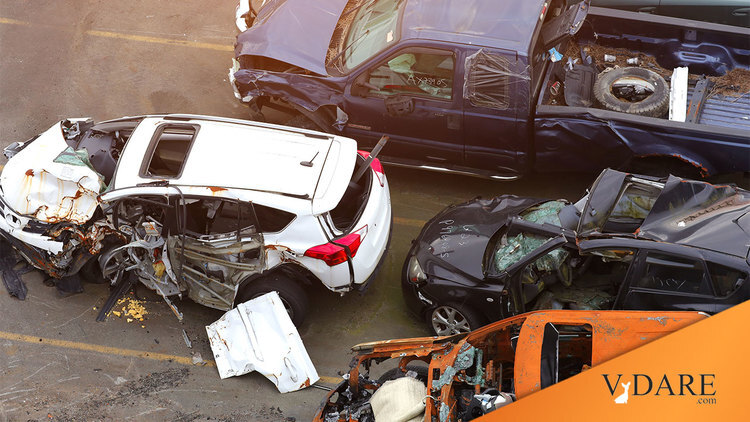
NBER On The Racial Wreckening On The Roads: "A New Racial Disparity in Traffic Fatalities"
By Steve Sailer
04/23/2023
From National Bureau of Economic Research:
A New Racial Disparity in Traffic Fatalities
Aaron Chalfin and Maxim N. Massenkoff
NBER Working Paper No. 30636
November 2022In 2015, for the first time in nearly forty years, the rate of motor vehicle fatalities for Black Americans exceeded that of white Americans. By 2020, the gap in death rates stood at 34%, accounting for approximately 4,000 excess deaths between 2014 and 2020. This disproportionate increase occurred in nearly all states, in rural as well as urban areas, and was shared by drivers of all ages and genders. We consider a variety of potential explanations for the emerging race gap including race-specific changes in time spent driving, the circumstances of driving, the quality of medical care for crash victims, decreases in other types of mortality, changes in policing, and risky driving behaviors such as speeding, driving without a seat belt and driving while intoxicated. We can rule out many of these factors as important contributors to the race gap, but find evidence for two of them. The first is opportunity: Relative to white Americans, Black Americans are spending more time in vehicles than they have in the past. Changes in time spent
driving, while modest, likely explain an important share of the emergent race gap….Prior to 2014, the average Black American and white American over the age of 15 spent 57.7 minutes per day and 67.4 minutes per day traveling in a vehicle, respectively. After 2014, this number rose to 60.8 minutes for Black Americans and fell to 66.0 minutes for white Americans. …

It’s been widely noted that young whites have less of a car culture than they used to, while blacks strike me as being more into vehicles than in the past. E.g., All-Terrain Vehicles were a white thing in the 20th century but now are a black thing. On the other hand, it appears that the white-black hours- in-vehicle gap expanded in 2020, when black traffic fatalities exploded, contrary to the authors’ theory that it is driving the post-2014 change.
The second is a relative increase in drug use, manifested by a quadrupling of the rate of overdose deaths among Black Americans after 2014. Increased drug use appears to have resulted in a concomitant increase in fatal crashes involving drivers under the influence of drugs.
The Sacklers and the cartels focused on hooking working class whites on painkillers and heroin in the early 21st century and avoided black inner cities. Then about the middle of the last decade you started hearing about blacks dying of opioids (e.g., Prince).
But I don’t recall ever hearing about an increase in traffic fatalities being one of the Deaths of Despair besetting the white working class in the opioid belts. In general, my impression is opioids make you want to stay home rather than roar around at 100 mph.
Finally, we consider whether the emerging race gap is explained by the so-called “Ferguson effect,” the idea that police officers have pulled back from enforcement activity in recent years. On the one hand, traffic stops made by police officers do appear to have declined after 2014. However, the decline in traffic stops does not appear to be race-specific and there is little evidence of a broad increase in risky driving behaviors like speeding and driving without a seat belt.
For some reason, everybody is driven insane with rage by my observation that it appears that on average that blacks benefit more from more policing because they tend to do less self-policing.
In the appendix of this paper, I found their table of death rates by race for each 10 million hours as a driver and/or passenger. (Other analysts use death rates per 100 million miles driven. I could see arguments for either.) Here’s my graph of their data:

It looks to me like blacks were slightly worse drivers than whites in the early 21st century. Then 2008 happened and more marginal black drivers than white drivers lost their rides. (The poorest blacks tend to live in cities with decent bus service, while the poorest whites tend to live in the sticks, so an economic downturn improves black driving a little more.) Thereafter blacks started to recover economically and the Ferguson Effect happened in some places.
Then 2020 happened, with cops initially social distancing themselves and making fewer stops, economic stimulus happening, followed by the George Floyd Racial Reckoning, and the black death rate went up an insane amount, more than doubling in one year.
